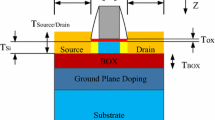Abstract
Recent years, the hardening of combinational circuits is becoming a common concern. Unlike the transistor-level hardening technique, the cell-level hardening technique, a divide and conquer strategy, can substantially make use of some typical character in the cell-circuit module to mitigate single event transient (SET) sensitivity. The mirror image (MI) technique proposed in this paper can adequately enhance the charge sharing in those cell-circuits with stage-by-stage inverter-like structure. 3D TCAD mixed-mode simulation have been performed in 65 nm twin-well bulk CMOS process, the results indicate that the MI technique can almost reduce the SET pulse width from the anterior-stage PMOS over 25 %, and can mitigate the SET pulse width from the posterior-stage PMOS about 10 %. The MI technique, a represent of the cell-level technique, may be the future of the hardening of combinational circuits.











Similar content being viewed by others
References
Amusan O, Witulski A, Massengill L et al (2006) Charge collection and charge sharing in a 130 nm CMOS technology. IEEE Trans Nucl Sci 53:3253–3258
Amusan A, Massengill L, Baze P et al (2007) Directional sensitivity of Single event upsets in 90 nm CMOS due to charge sharing. IEEE Trans Nucl Sci 54:2584–2589
Liu B, Chen S, Liang B et al (2009) Temperature dependency of charge sharing and MBU sensitivity in 130-nm CMOS technology. IEEE Trans Nucl Sci 56:2473–2479
Uznansk S, Gasiot G, Roche P et al (2010) Monte-Carlo based charge sharing investigations on a bulk 65 nm RHBD flip-flop. IEEE Trans Nucl Sci 57:3267–3272
Amusan O, Casey M, Bhuva B et al (2009) Laser verification of charge sharing in a 90 nm bulk CMOS process. IEEE Trans Nucl Sci 56:3065–3070
Harada R, Mitsuyama Y, Hashimoto M et al (2011) Neutron induced single event multiple transients with voltage scaling and body biasing. IEEE International Reliability Physics Symposium (IRPS) 253–257
Ahlbin J, Massengill L, Bhuva B et al (2009) Single-event transient pulse quenching in advanced CMOS logic circuits. IEEE Trans Nucl Sci 56:3050–3056
Ahlbin J, Gadlage M, Atkinson N et al (2010) Effect of multiple-transistor charge collection on single-event transient pulse widths. IEEE International Reliability Physics Symposium (IRPS) 198–202
Lee H, Lilja K, Bounasser M et al (2010) LEAP: layout design through error-aware transistor positioning for soft-error resilient sequential cell design. IEEE International Reliability Physics Symposium (IRPS) 203–212
Entrena L, Lindoso A, Millan E et al (2012) Constrained placement methodology for reducing SER under single-event-induced charge sharing effects. IEEE Trans Nucl Sci 59:811–817
George N, Lach J (2011) Characterization of logical masking and error propagation in combinational circuits and effects on system vulnerability. IEEE /IFIP 41st international conference on Dependable Systems & Networks (DSN) 323–334
Atkinson N, Witulski A, Holman W et al (2011) Layout technique for single-event transient mitigation via pulse quenching. IEEE Trans Nucl Sci 58:885–890
Musseau O, Cavrois V, Pelloie J et al (2000) Laser probing of bipolar amplification in 0.25-μm MOS/SOI transistors. IEEE Trans Nucl Sci 47:2196–2203
Amusan O, Massengill L, Bhuva B et al (2007) Design techniques to reduce SET pulse widths in deep-submicron combinational logic. IEEE Trans Nucl Sci 54:2060–2064
Zhang Q, Hou M, Liu J et al (2002) σ-LET curve obtained with heavy ions accelerated by HIRFL. Chin Sci Bull 47:1431–1433
Narasimham B, Bhuva B, Massengill L et al (2010) Scaling trends in SET pulse widths in sub-100 nm bulk CMOS processes. IEEE Trans Nucl Sci 57:3336–3341
Baumann R (2001) Soft errors in advance semiconductor devices—part I: the three radiation sources. IEEE Trans Dev Mat Rel 1:17–22
Chen J, Chen S, Liang B et al (2012) Simulation study of the layout isolation techniques for p-hit single-event transient mitigation. IEEE Trans Dev Mat Rel 12:501–509
Rodbell K, Heidel D, Pellish J et al (2011) 32 and 45 nm radiation-hardened-by-design (RHBD) SOI latches. IEEE Trans Nucl Sci 58:2702–2710
Chen J, Chen S, He Y et al (2012) Novel layout techniques for n-hit single-event transient mitigation by source extension. IEEE Trans Nucl Sci 59:2859–2866
Atkinson N (2010) Single-event characterization of a 90-nm bulk CMOS digital cell library. Dissertation for Master Degree, Vanderbilt University
Huang P, Chen S, Chen J et al (2013) Novel n-hit single event transient technique via open guard transistor in 65 nm bulk CMOS process. Sci China Tech Sci 56:271–279
Acknowledgments
This work was supported by the National Natural Science Foundation of China (61376109).
Author information
Authors and Affiliations
Corresponding author
About this article
Cite this article
Huang, P., Chen, S., Liang, Z. et al. Mirror image: newfangled cell-level layout technique for single-event transient mitigation. Chin. Sci. Bull. 59, 2850–2858 (2014). https://doi.org/10.1007/s11434-014-0409-0
Received:
Accepted:
Published:
Issue Date:
DOI: https://doi.org/10.1007/s11434-014-0409-0




